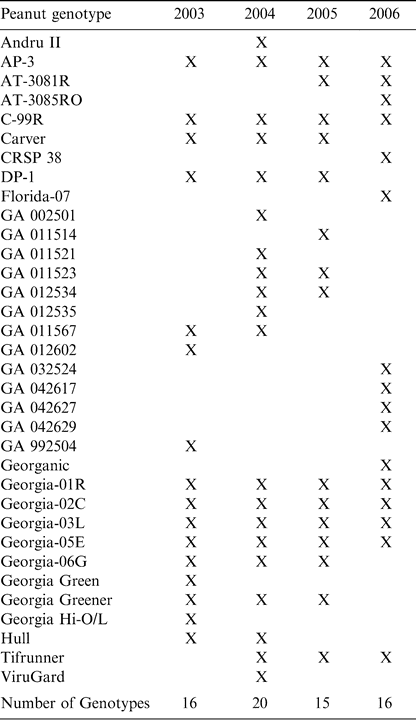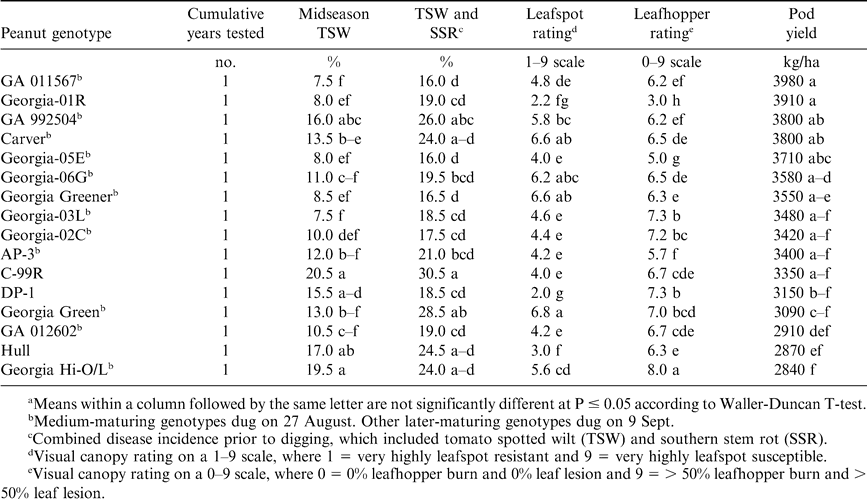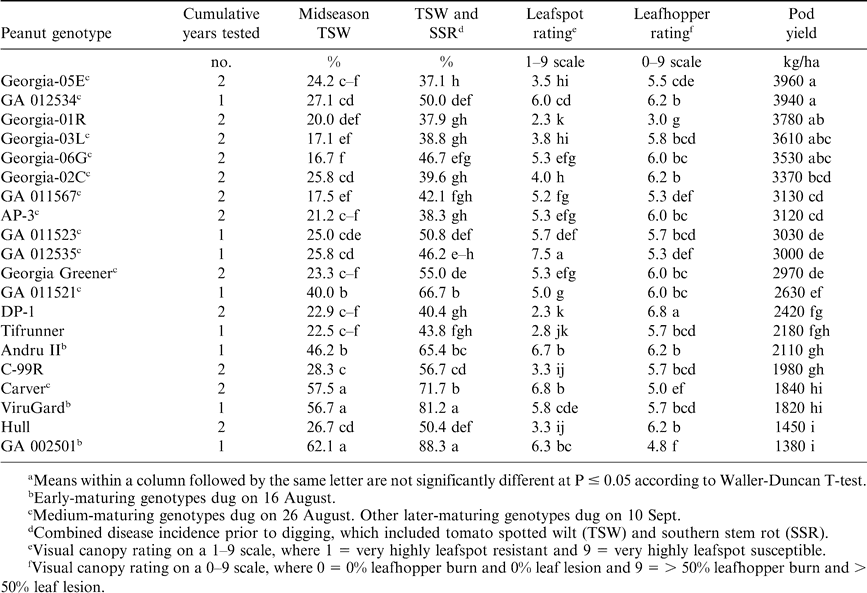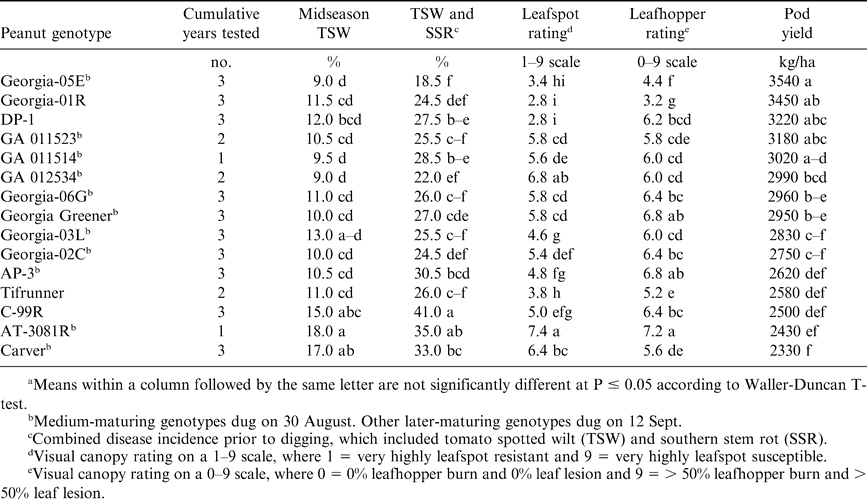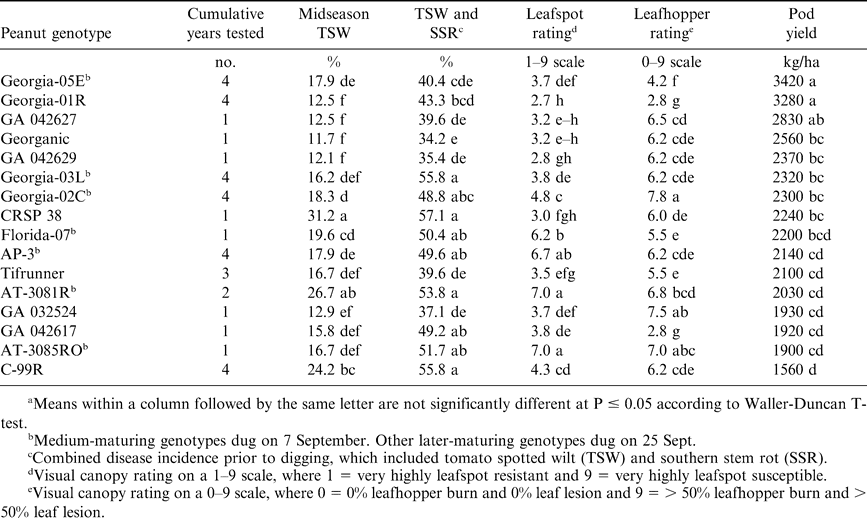Introduction
In the United States during the past decade, sales of organic food increased over 20% annually in natural product stores (Dimitri and Greene, 2002). However by 2000, natural product retailers and conventional food stores both sold 48% and 49%, respectively of all organic products (Dimitri and Greene, 2002). In 2000, conventional supermarkets also accounted for 99% of all food stores and are approximately equal to natural product stores in sales of organic food (Dimitri and Greene, 2002). Consequently, organically grown food is now more widely available for the increasing U.S. consumer demand. In 2005, organic products (food and drink) sold for an estimated $14.5 billion in the United States (Willer and Yussefi, 2006). Parker (2006) and Lamb (2006) stated that organically produced peanut (Arachis hypogaea L.) represented the fastest growing sector in the whole U.S. peanut industry.
Peanut production in the U.S. has become dependant upon numerous types of pesticides, including fungicides, herbicides, insecticides, miticides, and nematicides (Warren et al., 1995). Annually, pesticides contribute one of the largest input costs to U.S. peanut growers (Smith, 2006).
The most important and endemic foliar peanut diseases in the southeast U.S. are tomato spotted wilt (TSW) caused by Tomato spotted wilt virus and both early and late leafspots caused by Cercospora arachidicola Hori and Cercosporidium personatum (Berk. & Curt.) Deighton, respectively. Two of the most important and endemic insect pests on peanut are tobacco thrips (Frankliniella fusca Hinds) and potato leafhopper (Empoasca fabae Harris).
Current pesticides used in the U.S. are very effective, but expensive. Most can not be utilized in organic peanut production. To meet the challenge of producing peanuts without conventional pesticides, disease and insect resistant cultivars are needed. The objective of this study was to assess the performance of several different peanut genotypes grown without any fungicides and insecticides over multiple years as candidates for use in organic peanut production.
Materials and Methods
During 2003, 16 diverse peanut cultivars and advanced breeding lines developed by the University of Georgia were evaluated for disease and insect resistance and yield performance. Similarly in 2004, 2005, and 2006 the number of peanut genotypes evaluated were 20, 15, and 16, respectively.
Each year, no-fungicide and no-insecticide field trials were conducted on a Tifton loamy sand soil type (fine-loamy, siliceous, thermic Plinthic Kandindult) at the agronomy research farm near the University of Georgia, Coastal Plain Experiment Station. Plots consisted of two rows 6.1 m long × 1.8 m wide (0.8 m within and 1.0 m between adjacent plots). Planting dates were 23 April 2003, 16 April 2004, 20 April 2005, and 19 April 2006. Production practices included conventional tillage, fertilization, and irrigation, but excluded all pesticides, except for seed treatments which were utilized in these trials and preplant incorporated and postemergence herbicides as needed to maintain weed control of plots throughout the growing season. These field trials were in a three-year rotation. Peanut followed cotton in 2003, 2004, 2005, and corn in 2006. In general, individual susceptible entries were harvested based upon plant defoliation due to leafspot disease severity; whereas, the more resistant entries were dug near optimum maturity based upon hull-scrape determination from adjacent border plants (Williams and Drexler, 1981).
Incidence of tomato spotted wilt (TSW) was first assessed at about midseason, when TSW is usually the only disease occurring at this time during the growing season. Percentages (0–100%) of combined disease incidence were scored prior to digging, which included primarily TSW but also the soilborne disease, southern stem rot (SSR) caused by Sclerotium rolfsii Sacc. A disease hit equaled one or more diseased plants in a 30-cm section of row. Leafspot ratings among all genotypes were recorded on individual whole plots toward the end of each growing season. Early leafspot caused by Cercospora arachidicola Hori and late leafspot caused by Cercosporidium personatum (Berk. & Curt.) Deighton were both prevalent and evaluated together. A 1–9 visual canopy rating scale was used where 1 = very highly resistant and 9 = very highly susceptible plants (Pittman, 1995). Visual leafhopper damage ratings were also recorded on individual whole plots during the latter half of the growing season each year according to a 0–9 scale where 0 = 0% leafhopper burn and 0% leaf lesion; whereas, 9 = > 50% leafhopper burn and > 50% leaf lesion as previously reported (Branch and Todd, 2006). In general, disease and insect ratings represent an overall relative genotype assessment.
After digging and picking with a small-plot thresher, pods were dried with forced warm air to 6% moisture. Pod samples were then hand-cleaned over a screen table before weighing for yield determinations.
A randomized complete block design was used each year with six replications. Data from each test was statistically analyzed by analysis of variance. Waller-Duncan's T-test (k-ratio = 100) was used for mean separation.
Results and Discussion
Each year, different cultivars and advanced Georgia breeding lines were evaluated for disease and insect resistance and yield performance in no-fungicide and no-insecticide field trials (Table 1). Thus, combined years comparisons were not possible, since very few peanut genotypes were common across all 4 years (2003–2006).
At mid-season, incidence of tomato spotted wilt (TSW) varied from year to year (Tables 2– 5). During 2003, the lowest incidence or the highest level of resistance to TSW was found in ‘Georgia-03L’ (Branch, 2004) and the advanced Georgia breeding line, GA 011567 (Table 2). However, these two genotypes were not significantly (P ≤ 0.05) different from ‘Georgia-01R’ (Branch, 2002), ‘Georgia-05E’ (Branch, 2006), ‘Georgia-06G’ (Branch, 2007), ‘Georgia Greener’ (Branch, 2007), ‘Georgia-02C’ (Branch, 2003), ‘AP-3’ (Gorbet, 2007), ‘Georgia Green’ (Branch, 1996), and GA 012602. During 2004, 2005, and 2006, these same genotypes as in 2003 continued to exhibit the lowest TSW incidence along with ‘DP-1’, ‘Tifrunner’ (Holbrook, 2007), ‘Georganic’ (Holbrook, 2007), ‘AT-3085RO’, and the advanced Georgia breeding lines, GA 011523, GA 011514, GA 012534, GA 032524, GA 042617, GA 042627, and GA 042629 (Tables 3– 5). These results agree the previous report by Cantonwine et al., (2006) for TSW field resistance in Georgia-01R, Georganic (tested as C11-2-39), Tifrunner, and DP-1. Because there are few if any chemical control options available for managing spotted wilt disease in peanut, resistance found in released cultivars and advanced breeding lines is critical for both conventional and organic production systems.
As expected by the end of the growing season each year, the percentage of TSW and southern stem rot (SSR) disease greatly increased among all genotypes (Tables 2– 5). The peanut genotypes with the highest levels of TSW and SSR disease resistance were Georgia-05E (Tables 2, 3, and 4) and Georganic (Table 5). However, these two genotypes did not differ from many other genotypes each year in the final combined disease assessment.
During the latter half of each season, early leafspot began appearing as a few small necrotic lesions followed later by increasing numbers of early leafspots and the inclusion of late leafspot lesions. Georgia-01R and DP-1 consistently had the highest level of leafspot resistance each year (Tables 2– 5). These findings also collaborate a previous report of leafspot suppression in these two cultivars (Cantonwine et al., 2006). However, these leafspot resistant genotypes were not significantly different from Hull in 2003 (Table 2), Tifrunner in 2004 (Table 3), Georgia-05E in 2005 (Table 4), or Georganic, GA 042627, GA 042629, and CRSP 38 in 2006 (Table 5). It should also be noted that most of the leafspot resistance found was in the later-maturing genotypes. However, Georgia-03L has medium maturity and was found to have moderate leafspot resistance (Tables 2– 5).
Unfortunately, little if any thrips resistance is currently available, and thrips damage was noticeably uniform and severe early in the growing season each year. However, plants typically recover by mid-season. Based on observation of thrips feeding injury, there appeared to be no indication of thrips resistance among the genotypes evaluated in this study.
Shortly after thrips recovery, leafhopper burn appears as the classic “v-shape” chlorosis on the leaflet tips and progressed toward necrosis later in the season. Across all four years, Georgia-01R consistently had the highest level of leafhopper resistance among all genotypes, except for GA 042617 during 2006 (Table 5). These results agree with the earlier report by Branch and Todd (2006), regarding leafhopper resistance of Georgia-01R.
As previously reported by Branch and Fletcher (2001), pod yield performance was found to be relatively low among all peanut genotypes when grown without fungicides or insecticides. However, in this study two Georgia cultivars, Georgia-01R and Georgia-05E, were among the highest yielding genotypes evaluated in all four years (Tables 2– 5). Cantonwine et al., (2006) also reported that Georgia-01R performed very well in integrated disease management experiments that included no-fungicide and reduced-fungicide regimes.
Georgia-01R is a multiple-pest-resistant, mid-oleic, runner-type cultivar with late maturity; whereas, Georgia-05E is a multiple-pest-resistant, high-oleic, virginia-type cultivar with medium-late maturity. Both of these cultivars have high levels of resistance to several pathogens and insects, which makes each cultivar a good candidate for potential use in organic peanut production.
Literature Cited
Branch W. D. 1996 Registration of ‘Georgia Green’ peanut. Crop Sci 36 : 806 .
Branch W. D. 2002 Registration of ‘Georgia-01R’ peanut. Crop Sci 42 : 1750 – 1751 .
Branch W. D. 2003 Registration of ‘Georgia-02C’ peanut. Crop Sci 43 : 1883 – 1884 .
Branch W. D. 2004 Registration of ‘Georgia-03L’ peanut. Crop Sci 44 : 1485 – 1486 .
Branch W. D. 2006 Registration of ‘Georgia-05E’ peanut. Crop Sci 46 : 2305 .
Branch W. D. 2007 Registration of ‘Georgia-06G’ peanut. J. Plant Reg 1 : 120 .
Branch W. D. 2007 Registration of ‘Georgia Greener’ peanut. J. Plant Reg 1 : 121 .
Branch W. D. and Fletcher S. M. 2001 No-pesticide preliminary yield trials in peanut. Peanut Sci 28 : 21 – 24 .
Branch W. D. and Todd J. W. 2006 New source of leafhopper resistance in peanut. J. Entomol. Sci 41 / 3 : 198 – 201 .
Cantonwine E. G. , Culbreath A. K. , Steveson K. L. , Kemerait R. C. , Brenneman T. B. , Smith N. B. , and Mullinix B. G. 2006 Integrated disease management of leafspot and spotted wilt of peanut. Plant Dis 90 : 493 – 500 .
Dimitri C. and Greene C. 2002 Recent growth patterns in the U.S. organic foods market. U.S.D.A.-Econ. Res. Ser. Agric. Info. Bull. No. 777 Available at http://www.ers.usda.gov/publications/aib777/aib777c.pdf.
Gorbet D. W. 2007 Registration of ‘AP-3’ peanut. J. Plant Reg 1 : 126 – 127 .
Holbrook C. C. and Culbreath A. K. 2007 Registration of ‘Tifrunner’ peanut. J. Plant Reg 1 : 124 .
Holbrook C. C.
and
Culbreath A. K.
2008
Registration of ‘Georganic’ peanut.
J. Plant Reg
2
:
17
doi: 10.3198/jpr2007.03.0172crc
.
Lamb M. C. 2007 The economics of organic versus conventional peanuts. 2006 Proc. Am. Peanut Res. Educ. Soc 38 : 92 .
Parker B. 2007 Organic peanut production in the US: the sheller's perspective. 2006 Proc. Am. Peanut Res. Educ. Soc 38 : 92 .
Pittman R. N. 1995 United States Peanut Descriptors. USDA, ARS-132 Washington, DC U.S. Govt. Print. Ofc .
Smith N. B. 2006 Peanut cost analyses for 2006. 58 – 65 In Prostko E. P. 2006 Peanut Update CSS-06-0112 . Univ. of GA, Coop. Ext. Rept .
Warren R. L. , Weber J. B. , and Danielson L. E. 1995 Pesticide behavior in soils and groundwater protection in peanut management systems. 245 – 285 In Pattee H. E. and Stalker H. T. Advances in Peanut Science Stillwater, OK Amer. Peanut Res. Educ. Soc.,Inc .
Williams E. J. and Drexler J. S. 1981 A non-destructive method for determining peanut pod maturity. Peanut Sci 8 : 134 – 141 .
Willer H. and Yussefi M. 2006 The world of organic agriculture – statistics and emerging trends. Bonn, Germany International Federation of Organic Agriculture Movements Available at http://orgprints.org/5161/01/yussefi-2006-overview.pdf (cited 30 Jan. 2007).
Notes
- Dept. of Crop and Soil Sciences and Dept. of Plant Pathology, respectively, University of Georgia, Coastal Plain Experiment Station, Tifton, GA 31793-0748 [^] * Corresponding author (e-mail: wdbranch@uga.edu).
Author Affiliations


